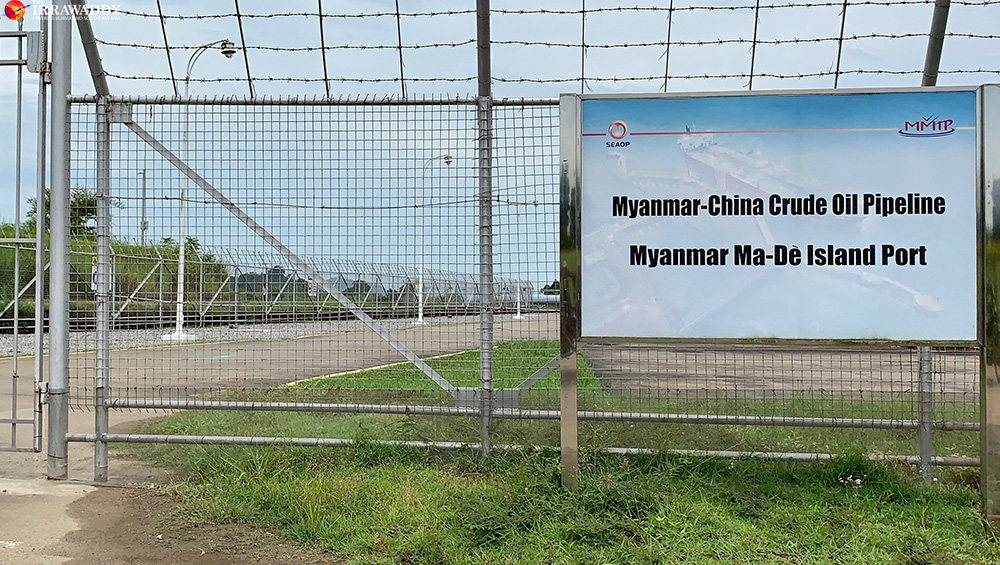YANGON—China’s ambassador to Myanmar pushed on Wednesday to gear up for the implementation of Beijing’s key infrastructure projects in Myanmar despite the fact that both countries’ economies are facing a significant slowdown due to the effects of the COVID-19 pandemic.
Chinese Ambassador to Myanmar Chen Hai and Myanmar’s Deputy Minister for Planning, Finance and Industry U Set Aung met for ‘in-depth discussions’ Wednesday on the implementation of outcomes from Chinese President Xi Jinping’s visit to Myanmar in January, according to the Chinese Embassy in Myanmar.
The Chinese Embassy said that the two discussed how to move forward on the development of China’s ambitious projects in Myanmar based on the Myanmar government’s COVID-19 Economic Relief Plan (CERP). The projects discussed included New Yangon City, Kyaukphyu Deep-Sea Port and Industrial Zone and the China-Myanmar Border Economic Cooperation Zone.
Launched last week, the CERP seeks to mitigate the economic impact of the pandemic by implementing new measures and response plans. The measures include steps to expedite the solicitation of strategic infrastructure projects and to approve and disclose large investments by reputable international firms that may be currently experiencing delays, through fast-track procedures.
The head of the China desk at the Institute for Strategy and Policy (ISP), Daw Khin Khin Kyaw Kyee, told The Irrawaddy that these three projects constituted the main agenda when Xi came to Myanmar, as they are strategically important for China, and that it’s important to China’s image to actually implement the agreements from his visit.
“The CERP is considered a roadmap for the country for both during outbreak and the post-COVID-19 period. If the projects are added to the CERP, they could be considered priority projects [to implement]. That’s the reason China wants to link their projects with the CERP,” Daw Khin Khin Kyaw Kyee said.
During Xi’s trip to Myanmar, these projects were branded as three pillars of the China-Myanmar Economic Corridor (CMEC), itself a part of China’s Belt and Road Initiative (BRI). Xi also called for both sides to deepen “result-oriented Belt and Road cooperation” and move from “the conceptual stage to concrete planning and implementation” of building the CMEC.
On Xi’s trip in January, the Chinese president and Myanmar leaders inked a concession agreement and shareholders’ agreement for Kyaukphyu Special Economic Zone (SEZ), a letter of intent on the New Urban Development of Yangon City, and a memorandum of understanding (MoU) to accelerate negotiations around the Ruili-Muse Cross-Border Economic Cooperation Zone.

The Chinese Embassy said that as the pandemic has pushed the global and regional economy into a slump, China and Myanmar must strengthen cooperation to advance the CMEC to promote economic development and improve people’s livelihoods.
The World Bank has warned that Myanmar’s GDP growth will likely slow to between 2 and 3 percent in the current fiscal year due to the pandemic, and that poor and vulnerable households across the country will be hit the hardest.
The BRI is Xi’s signature foreign policy project. Unveiled in 2013, it is also known as the Silk Road Economic Belt and the 21st-Century Maritime Silk Road. The project aims to build a network of roads, railroads and shipping lanes linking at least 70 countries from China to Europe, passing through Central Asia, the Middle East and Russia and fostering trade and investment.
Myanmar signed an MoU to establish the CMEC in 2018. The 1,700-kilometer corridor will connect Kunming, the capital of China’s Yunnan province, to Myanmar’s major economic hubs—first to Mandalay in central Myanmar, and then east to Yangon and west to the Kyaukphyu SEZ in western Rakhine State.
A framework agreement on the ambitious Kyaukphyu SEZ was inked in November 2018, with Myanmar holding 30 percent of the shares in the project. The project is expected to boost development in landlocked Yunnan and provide China with direct access to the Indian Ocean, allowing its oil imports to bypass the Strait of Malacca.
New Yangon City is a controversial project launched by the Yangon regional government via the government-owned New Yangon Development Company (NYDC) in 2018 and aims to build a new city across the Yangon River from the existing city. The new development would be twice the size of Singapore.
The NYDC signed a framework agreement with China Communications Construction Co. Ltd (CCCC) for Stage 1 Infrastructure Projects including two bridges, roads, power plants, water and wastewater treatment plants and a 10-square-kilometer industrial estate.
Since NYDC announced plans to implement the project, the slated new city has been a source of controversy. Town planners raised the alarm over the flood-prone location of the project, and the Yangon Regional government was accused of abusing its power by investing 10 billion kyats (US$7.2 million) in the project without prior approval from the regional parliament. Moreover, Chinese firm CCCC has been embroiled in a number of controversies over its involvement in alleged fraud, corruption and bribery in many other countries where it implemented development projects.
Furthermore, agreements to establish cross-border economic cooperation zones along the borders in Shan and Kachin states were among the very first agreements between the National League for Democracy (NLD)-led government and China in 2017.
The three approved zones are in Shan State’s Muse Township, Chinshwehaw in Shan State’s Laukkai Township, which is part of the Kokang Self-Administered Zone, and Kanpiketi Town in Kachin State’s Special Region 1, currently under the control of the New Democratic Army-Kachin militia, a Border Guard Force allied with the Myanmar military.
Meanwhile, the Myanmar government is planning to sign a framework agreement for the zone in Muse, which will pave the way to implementation on the ground.
You may also like these stories:
Myanmar’s COVID-19 Economic Relief Plan Attracts Mixed Reactions from Industrial Insiders
Six Labor Strike Leaders Jailed for Breaking Myanmar’s COVID-19 Rules
Two More Myanmar Military Officers Catch COVID-19 in Moscow

















